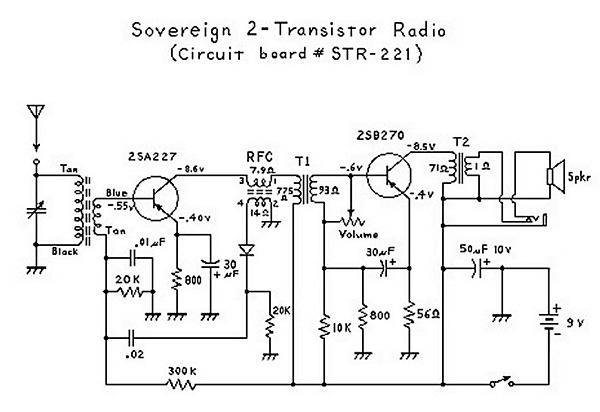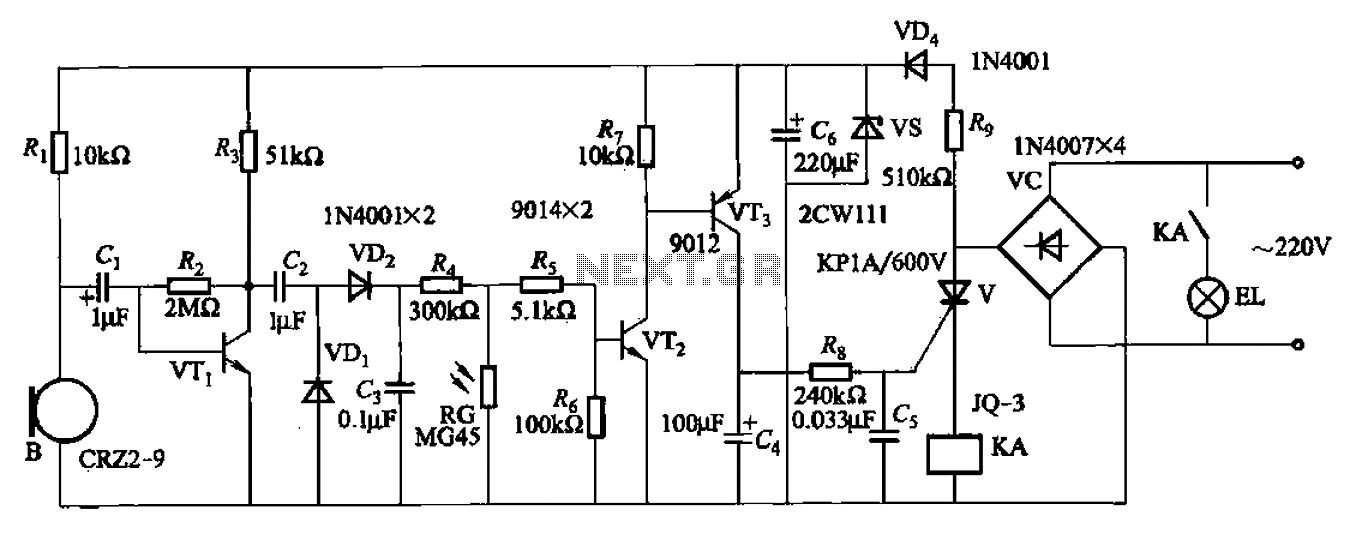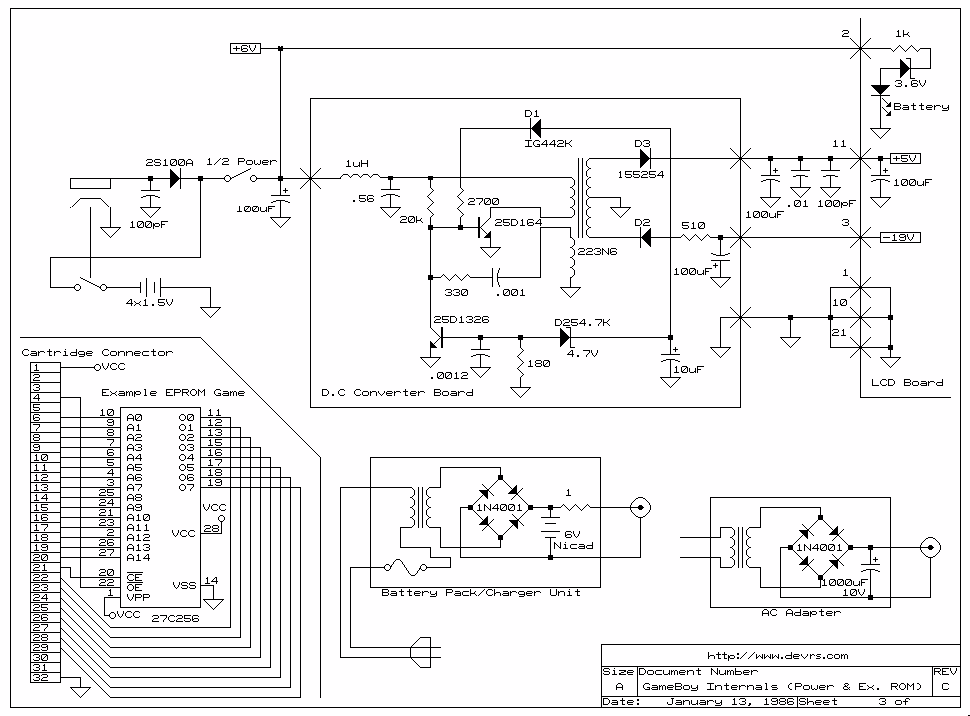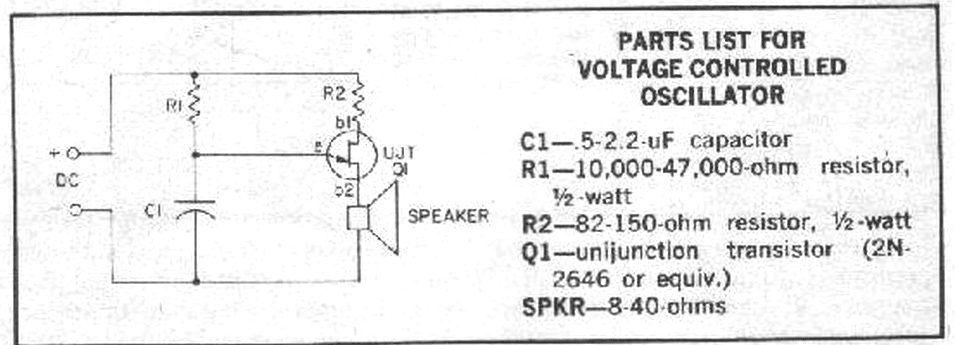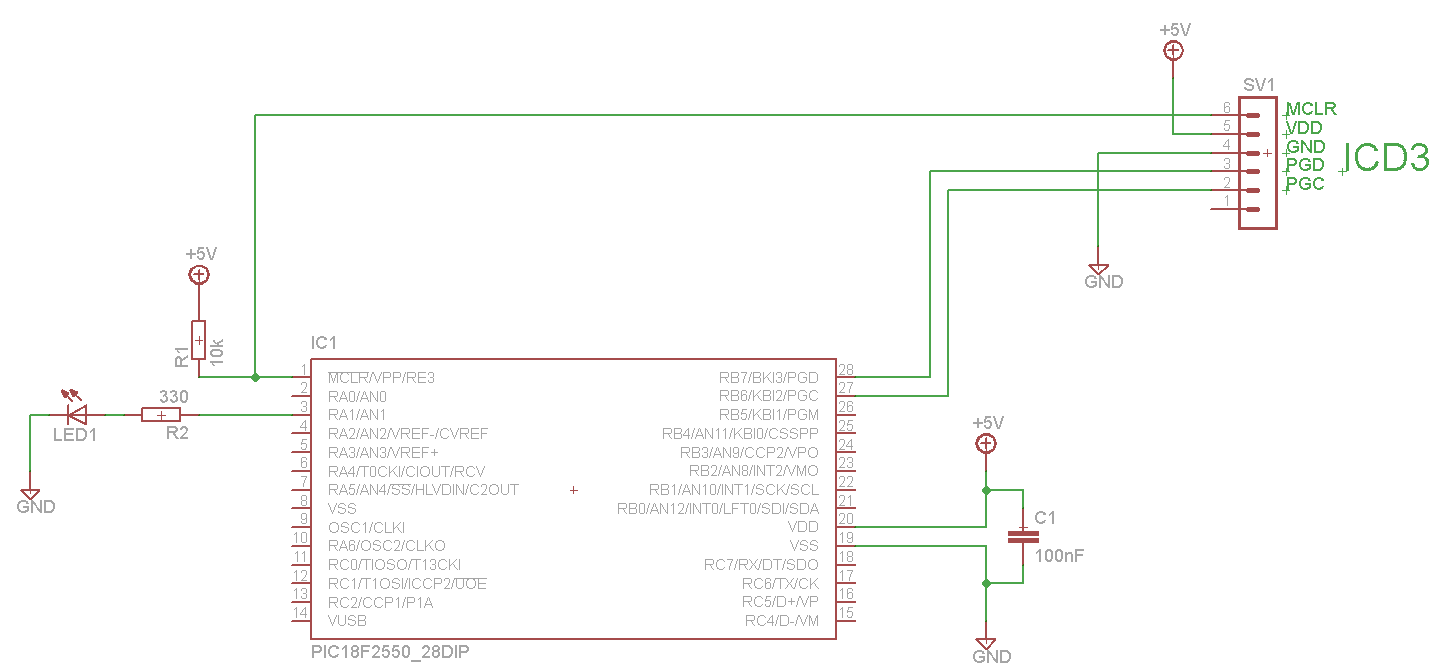
Basic Transistor Circuits
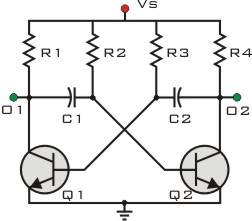
This circuit is designed to drive a relay coil using a low power output, typically from an integrated circuit (IC) such as a 555 timer or a TTL/CMOS device. It facilitates the switching of high loads or loads requiring AC current for operation. The relay is activated when the circuit's input signal goes high. A protection diode (Dp) is included to safeguard the transistor from reverse current generated by the relay coil during the switch-off phase. The values for the base resistor (Rb) and transistor (Qs) vary accordingly. To calculate these values, the transistor's hFE must be determined, which should be at least five times the load current (IL) divided by the maximum output current from the input to the base of the transistor. The base resistor (RB) can be calculated if the input is derived from a component (potentially an IC) that shares the same power supply (Vs) as the transistor. For example, an output from a 74LS series TTL IC is required to operate a relay with a 160-ohm coil, supplied with 12V for the transistor and 5V for the IC, which can deliver a maximum current of 2mA. A transistor can be configured to switch a load (RL) based on a sensor's input. In this scenario, the sensor is a light-dependent resistor (LDR), which varies its resistance in response to light exposure. The left circuit configuration activates the load when the LDR is in darkness, while the right configuration activates the load when light is detected by the LDR. A potentiometer (RS) controls the sensitivity of the automation, with a suggested value of 10 kΩ. Additionally, a resistor labeled RP in the left circuit protects the transistor when the potentiometer is set to low values, with recommended values ranging from 1 kΩ to 22 kΩ, depending on the LDR. It is advisable to use low current loads with this circuit. There exists a threshold where the transistor may not be fully on or off, posing a risk of overheating, particularly with larger loads like lamps and motors. In such cases, a second transistor can be employed as a driver. A Darlington pair, consisting of two transistors connected together, exhibits very high current gain. The overall gain of the Darlington pair allows it to function similarly to a single transistor but with significantly higher current gain. It is important to note that at least 0.7 volts is required across both base-emitter junctions, necessitating a minimum of 1.4 volts to switch on the pair. Darlington pairs can be obtained as complete packages or constructed from two discrete transistors. The first transistor may be a low power type, while the second typically requires a higher power rating. The maximum collector current (Ic(max)) for the pair corresponds to the Ic(max) of the second transistor. Due to its sensitivity to small current changes, a Darlington pair can be utilized to create a touch sensor switch, as depicted in the left schematic. The protective resistor (RP) should be approximately 100 kΩ to prevent short-circuiting of the sensor plates. This circuit also functions as a monostable multivibrator. When an input pulse is received, the output transitions high and remains high for a duration determined by the time constant of capacitor C1 and resistor R2. While the output is high, input pulses will not influence the circuit. If the input is triggered and maintained high beyond the time constant defined by C1 and R2, the output will not remain high longer than the time constant.
The circuit operates by utilizing a relay to control larger loads through a low-power signal. The relay coil is energized when the input signal is high, allowing for the switching of devices that require higher voltages or currents than the control circuit can provide directly. A critical aspect of this design is the protection diode, which prevents damage to the transistor from the back EMF generated when the relay coil is de-energized. The calculations for the base resistor and transistor selection ensure that the transistor operates within safe limits, providing adequate current gain to switch the relay effectively.
In applications where the load may vary significantly, such as with an LDR, the inclusion of a potentiometer allows for fine-tuning of the circuit's sensitivity to light changes. The use of a Darlington pair enhances the circuit's capability to drive larger loads while maintaining a low input current requirement, thus enabling the design of touch-sensitive switches or other automation features. The monostable multivibrator function adds versatility, allowing the circuit to respond to transient input signals and maintain a stable output state for a predetermined duration, making it suitable for various timing and control applications. Overall, this circuit design showcases the integration of basic electronic components to create a functional and adaptable system for controlling higher power devices with low-power control signals.This circuit will drive a relay coil from a low power output, usually from an IC like 555 or a TTL/CMOS. It is used to switch high loads or loads that needs AC current to operate. The relay will be actuated when the input of the circuit goes high. The protection diode Dp is used to protect the transistor from the reverse current generated from the
coil of the relay during the switch off time. The values for Rb and Qs vary accordingly. The way to calculate them is: Then we calculate the transistor hFE. It must be at least 5 times the load current IL divided by the maximum output current from the Input to the base of the transistor Then you calculate the base resistor RB, If the input is taken from a component (possible an IC) that uses the same power supply as the transistor (that is Vs), then the form is: The output from a 74LS series TTL IC is required to operate a relay with a 160 Ohm coil. The supply voltage is 12V for the transistor and 5V for the IC. The IC can supply a maximum current of 2mA. A transistor may be connected in a way that will switch on and off a load (RL) according to a sensor.
In our example, the sensor is an LDR. The LDR is a resistor that will change it`s resistance according to the light falling on the sensor. The left circuit will switch on the load when the LDR is in dark, and the right will switch on the load when light fall on the LDR. The potentiometer RS will control the sensitivity of the automation. You should consider using a potentiometer 10Kohms. Also note the resistor on the left circuit labeled RP. This resistor is used to protect the transistor when the potentiometer is switched to low values. This RP should be from 1Kohm to 22Kohms. Select according to your LDR. You should consider using low current loads using this circuit. There is a point that the transistor will not be either on or off. In this case, there is danger overheating the transistor if you have big loads like lamps and motors.
In this case, you should use a second transistor connected as a driver. The Darlington pair consists of two transistors connected as the drawing. This connection have the characteristic of very high current gain. Actually, the overall gain is: A Darlington pair will act exactly as a single transistor only with very high current gain. Also, because there must be at least 0. 7volts in both base-emitter junctions, to switch on a pair like that will need at least 1. 4volts. Darlington pairs are available as complete packages but you can make up your own from two transistors.
The first transistor can be a low power type, but normally the second transistor will need to be high power. The maximum collector current Ic(max) for the pair is the same as Ic(max) for the second transistor. Because a Darlington pair will respond to very small current changes, you can make a touch sensor switch like seen on the schematic left.
The RP is a protective resistor, about 100Kohms, in case of short-circuiting the sensor plates. This circuit will perform a monostable multivibrator. When an input pulse occurs, the output goes high and remains high as per time constant of C1 and R2. While the output is high, the input pulses have no effect on the circuit. Also, If the input is triggered and kept high longer than the time constant of C1 and R2, the output will NOT stay high for longer than C1 R2 time constant. The time constant is: 🔗 External reference
The circuit operates by utilizing a relay to control larger loads through a low-power signal. The relay coil is energized when the input signal is high, allowing for the switching of devices that require higher voltages or currents than the control circuit can provide directly. A critical aspect of this design is the protection diode, which prevents damage to the transistor from the back EMF generated when the relay coil is de-energized. The calculations for the base resistor and transistor selection ensure that the transistor operates within safe limits, providing adequate current gain to switch the relay effectively.
In applications where the load may vary significantly, such as with an LDR, the inclusion of a potentiometer allows for fine-tuning of the circuit's sensitivity to light changes. The use of a Darlington pair enhances the circuit's capability to drive larger loads while maintaining a low input current requirement, thus enabling the design of touch-sensitive switches or other automation features. The monostable multivibrator function adds versatility, allowing the circuit to respond to transient input signals and maintain a stable output state for a predetermined duration, making it suitable for various timing and control applications. Overall, this circuit design showcases the integration of basic electronic components to create a functional and adaptable system for controlling higher power devices with low-power control signals.This circuit will drive a relay coil from a low power output, usually from an IC like 555 or a TTL/CMOS. It is used to switch high loads or loads that needs AC current to operate. The relay will be actuated when the input of the circuit goes high. The protection diode Dp is used to protect the transistor from the reverse current generated from the
coil of the relay during the switch off time. The values for Rb and Qs vary accordingly. The way to calculate them is: Then we calculate the transistor hFE. It must be at least 5 times the load current IL divided by the maximum output current from the Input to the base of the transistor Then you calculate the base resistor RB, If the input is taken from a component (possible an IC) that uses the same power supply as the transistor (that is Vs), then the form is: The output from a 74LS series TTL IC is required to operate a relay with a 160 Ohm coil. The supply voltage is 12V for the transistor and 5V for the IC. The IC can supply a maximum current of 2mA. A transistor may be connected in a way that will switch on and off a load (RL) according to a sensor.
In our example, the sensor is an LDR. The LDR is a resistor that will change it`s resistance according to the light falling on the sensor. The left circuit will switch on the load when the LDR is in dark, and the right will switch on the load when light fall on the LDR. The potentiometer RS will control the sensitivity of the automation. You should consider using a potentiometer 10Kohms. Also note the resistor on the left circuit labeled RP. This resistor is used to protect the transistor when the potentiometer is switched to low values. This RP should be from 1Kohm to 22Kohms. Select according to your LDR. You should consider using low current loads using this circuit. There is a point that the transistor will not be either on or off. In this case, there is danger overheating the transistor if you have big loads like lamps and motors.
In this case, you should use a second transistor connected as a driver. The Darlington pair consists of two transistors connected as the drawing. This connection have the characteristic of very high current gain. Actually, the overall gain is: A Darlington pair will act exactly as a single transistor only with very high current gain. Also, because there must be at least 0. 7volts in both base-emitter junctions, to switch on a pair like that will need at least 1. 4volts. Darlington pairs are available as complete packages but you can make up your own from two transistors.
The first transistor can be a low power type, but normally the second transistor will need to be high power. The maximum collector current Ic(max) for the pair is the same as Ic(max) for the second transistor. Because a Darlington pair will respond to very small current changes, you can make a touch sensor switch like seen on the schematic left.
The RP is a protective resistor, about 100Kohms, in case of short-circuiting the sensor plates. This circuit will perform a monostable multivibrator. When an input pulse occurs, the output goes high and remains high as per time constant of C1 and R2. While the output is high, the input pulses have no effect on the circuit. Also, If the input is triggered and kept high longer than the time constant of C1 and R2, the output will NOT stay high for longer than C1 R2 time constant. The time constant is: 🔗 External reference
